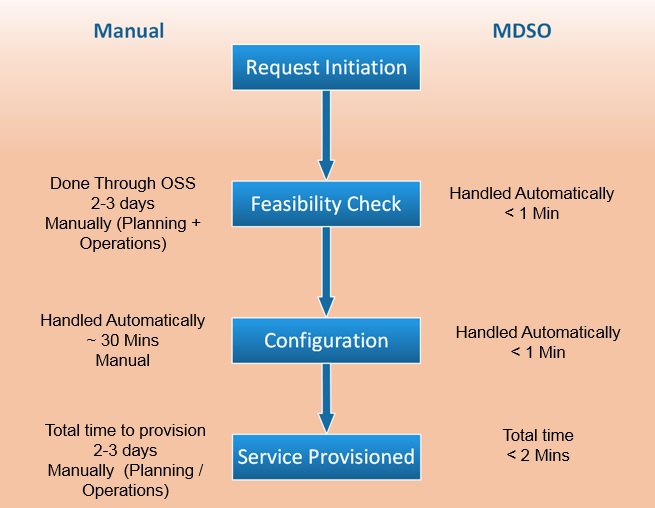Delivering high-bandwidth, revenue-generating services in minutes, not months
Many operators’ networks have grown organically to keep pace with rapidly growing traffic demands, with new technology added incrementally over time. This has resulted in multi-vendor, multi-domain networks that are difficult to manage and support. There are also major challenges when it comes to understanding where available capacity exists in the network, requiring consultation between multiple teams before new services can be provisioned and turned up. Additional effort and lead time are needed when service offerings are being newly designed and rolled out to the market.
These challenges typically result in very high costs for operators, who spend large amounts of time performing manual ordering, feasibility appraisals for new services involving multiple teams, manual configuration steps, and manual resource provisioning across several network layers and domains. As an additional challenge, new multi-vendor, physical or virtual network elements that support new service offerings may need to be introduced and integrated into Operational Support Systems (OSS) on a piecemeal basis, resulting in costly integration projects that result in a more complex operational environment.
Without a simple way to assess available capacity across the network, planning for new services is a time-consuming and difficult process.
Without a simple way to assess available capacity across the network, planning for new services is a time-consuming and difficult process. Most operators remain highly dependent on their vendor relationships in this regard, putting in frequent requests to understand if new services can be supported on existing infrastructure. Sometimes there is available capacity on the network, while other times a network buildout needs to be initiated with a vendor change request – which can be very time consuming and expensive.
All of this makes current, manual approaches to capacity planning and service provisioning unsustainable, particularly as customers’ expectations for on-demand, high-speed connectivity services continue to increase. To stay ahead of demand, and to minimise internal operational costs, operators need a more efficient, more automated way to gain visibility of their available network resources and capacity and to bring new services to market for their customers rapidly.
Boosting efficiency, agility, and time to market with WAN Automation
WAN Automation is architected with a single orchestration layer that interfaces with domain controllers from multiple vendors, providing visibility of all available resources across multi-vendor network elements, end-to-end. This allows operators to immediately assess the feasibility of delivering a new optical or Ethernet service over the network using resources that already exist. Furthermore, the orchestrator automates service provisioning and turn up across all the required network elements, dramatically reducing operational costs and speeding up time to service revenue.
Another key benefit is the ability to plan effectively for future growth and, as a result, to keep pace with customers’ accelerating bandwidth demands. With tools to see ‘supply and demand’ in the network in real time, operators can evolve and scale their environments in the most cost-effective way possible, and align infrastructure resources to support current, and future, use cases.
WAN Automation is architected with a single orchestration layer that interfaces with domain controllers from multiple vendors, providing visibility of all available resources across multi-vendor network elements, end-to-end.
Critically, WAN Automation also simplifies integration of network management processes with OSS processes, through a single northbound interface from the orchestrator into the OSS. Since the orchestrator abstracts the complexity of underlying multi-vendor elements, it eliminates the need to develop separate interfaces from the OSS for each set of vendor equipment, whenever that equipment changes. This is needed, not just to streamline the service order management process, but to also collect and present performance metrics and fault management data. By simplifying integration into the OSS in this way, WAN Automation reduces OSS custom development requirements and delivers major time and cost savings for operators.
About Blue Planet WAN Automation
Ciena’s Blue Planet Multi-Domain Service Orchestration (MDSO) software allows operators to automate end-to-end service provisioning across complex physical and virtualised network elements, while also providing a clear view of network resources and interdependencies to streamline future capacity planning.
Unique benefits of the Ciena Blue Planet WAN Automation solution include:
- Reduced time to market with Multi-Domain Service Orchestration (MDSO) - By orchestrating processes between multi-vendor domains, operators can support zero-touch provisioning of new services across their networks. This eliminates the need for different teams in the organisation, including IT, planning, engineering and operations teams, to communicate manually and to agree on a strategy for resource allocation and provisioning, typically reducing the time needed to provision and launch new services from several weeks to just a few minutes.

- ‘Bandwidth-on-Demand’ (BoD) via customer self-service portal- Customers can use a convenient self-service portal to request new services, or to scale existing services up or down, now or at some time in the future. Bandwidth-on-Demand uses the same tools as zero-touch provisioning to assess the feasibility of the customer request and to allocate resources automatically. With no manual steps in the process, customers can access high-speed services extremely quickly. Workloads and costs are also reduced for internal teams, delivering significant cost savings for operators.
- Enhanced capacity planning for efficient network evolution – The solution provides internal teams with a real-time view of the status of the network, available capacity and performance metrics on user-configurable dashboards. With a clear, real-time view of equipment status, service status, network status and resource utilisation, operators can plan their network evolution more effectively, and ensure that the network can keep pace with customers’ bandwidth, service, and QoS demands. Blue Planet’s WAN automation solution also incorporates inventory management tools to map the current operating environment, keep auditable records of historical infrastructure and changes, and simulate future inventory requirements in the network.
Ciena is already delivering these benefits for several tier-1 network operators around the world. For example, a tier-1 operator has been able to reduce time to market for high-speed services from an average of two months to just a few minutes. At the same time, the operator has a real-time view of network resources across multiple network domains and multi-vendor elements, helping to increase utilisation and efficiency, and ensuring that capacity keeps pace with growing customer demand.






